Where appropriate, Albany is apologetic. Albany asks you to please pardon its dust. It thanks you for your patience while it is improving what all the signs call “your arena,” and which is more correctly called the Times Union Center and which is currently surrounded by a DMZ of chain link fences and construction ditches and a half-mile or so of extremely stressed-out plastic tarp, which didn’t so much billow as suffer loudly in cold wind. There is a Chinese restaurant behind two tiers of fencing and one of those pipe gullies, and I smell the dense fryer-basket fact of it for nearly two days before I’m even able to make out a green awning with the words “Lam’s Kitchen” on it. Across the street, a jeweler’s shop, shut tight for the weekend, has an LED sign in its window that scrolls CASH YOUR GOLD/WATCH BATTERIES/EXPERT REPAIRS/JESUS IS THE LIFE. When a cab driver drops me off a couple of blocks away, he says “well, welcome to Albany, I guess.”
He did not know about that night’s MAAC-N-Cheese Fest, at the new convention center that had opened just two days earlier; neither did he know about the Metro-Atlantic Athletic Conference’s basketball tournament, which played its games in the Times Union Center all weekend, and which concludes on Monday night with Iona and Siena competing for the conference’s sole NCAA Tournament bid. He did know that Albany’s minor league hockey team was leaving, lost to Binghamton. They just couldn’t draw.
Videos by VICE
Read More: Lonzo Ball’s Ugly-Ass Jumper Would Be A Problem—If It Didn’t Go In
Albany is empty and cold and strange, at least downtown and at least on a weekend. A neighborhood of 1500 homes, 350 shops, and 29 bars was leveled six-odd decades ago to create the windswept flagstone plazas that stretch wide and empty between narrow brutalist towers with narrow brutalist names: Agency 3, Agency 4. The capitol building is ringed with metal barriers, and is all white granite cupolas and peaks—a prize-winning ice sculpture from which some laws periodically drip. Roads go under the plazas or are stymied by more sheer granite; the plazas close at night, as does the fluorescent catacomb of retail and administrative concourses that run under them. The Egg, a big commission from the Governor Nelson Rockefeller years that looks just like it sounds, looms over it all, not unattractively, but also not in a way that diminishes the feel that this is some deserted, possibly haunted post-Soviet capital city; “it could look like an egg,” Isaac Bashevis Singer reportedly said of it in 1983, “it could look like a blintz.” The combined impression is of a city called Gursk or Krply, where the parade grounds close whenever the big man in the gray suit is having a bad day; Brasilia without the weather, or food. There’s a real city in Albany, as it happens, but it’s not this, not the various campuses and grim towers that fill and empty every day. It’s indoors, or underground.
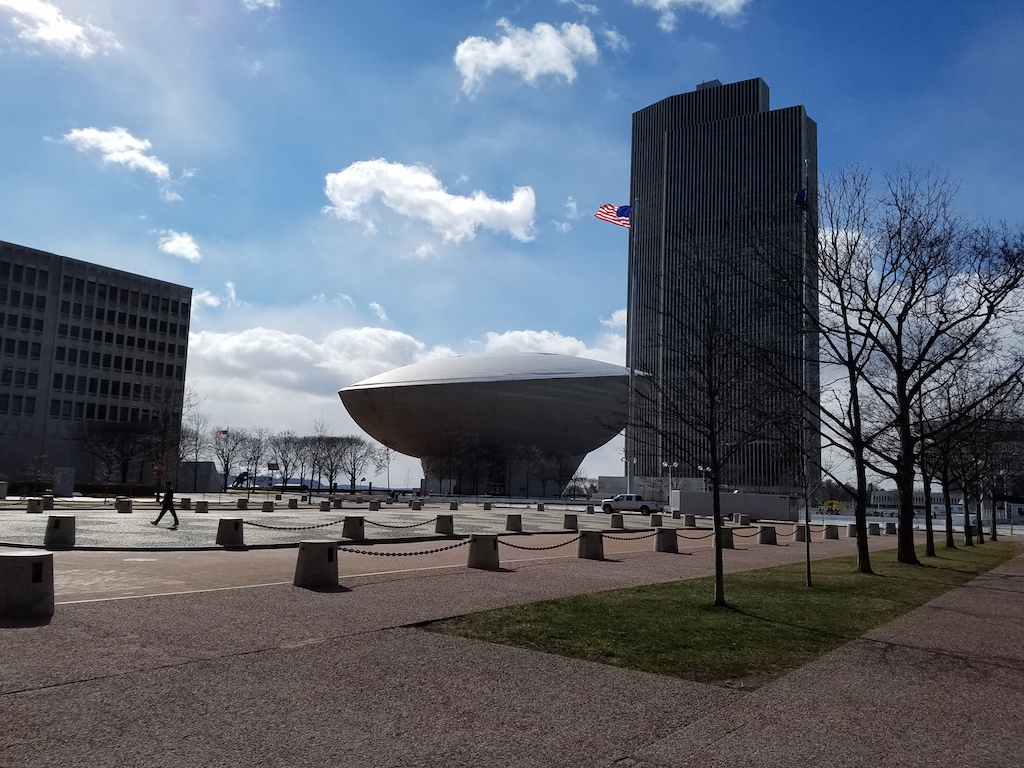
Welcome to the fucking moon. Photo by David Roth
MAAC-N-Cheese was pretty lit, for instance, largely because of the many charged-up kids in the building; a friend’s daughter proudly displays the basketball with a glittering comet’s tail that she’s had painted above her eye. Anthropomorphized Dunkin Donut cup and donut mascots twirl in space or Juju on that beat; they pair up for a pas de deux when the DJ plays I Had The Time Of My Life and kids watch warily. Men dunk off a trampoline. Drastic measures will be required where the carpet is concerned. The next morning, trying the doors at The Egg reveals an unexpected teakettle sound of kids, many kids, kids with access to sugar. A mother rides the long escalator up with her three children, trilling “whee” hopefully. They do the same thing back down the escalator, into the maw of a sprawling and inexplicable underground expo that nearly fills the warren of concourses and which I can only describe as A Trade Show, But For Children. The Jehovah’s Witnesses have a table there, as does the New York State Police; the tenders of several chocolate fountains charge a flat rate for three dips. I count three costumed Boba Fetts, each orbited by cautious-looking children; a tidal push of little girls approach and recede from three costumed princesses. A boy swinging a plastic lightsaber gets too close to one of the pieces of contemporary art Rockefeller hung in the halls and an alarm goes off; he’s carried away, crying. So here it is, or here something is.
Albany is a place, all right, and one that will feel familiar if you have ever visited a city dependent upon one industry, or figuring out how to survive without even one. Albany’s industry, the thing it can be most truly said to produce above any other, is administration, which is both an inexhaustible resource and not something that tends to bring in the sort of visitors who might be described as tourists. When the people that live there call it Small-bany they are not necessarily criticizing the place so much as they are saying that their experience of it is not the familiar overage or surprise of living in a city. It’s a bunch of little closed circuits in which everyone knows everyone, but maybe also already knows everyone. A pilgrim seeking a sense of place, of being somewhere, should go to the Times Union Center. You will please pardon the appearance while they fix your arena. You will go to the MAAC Tournament, into the little temporary world that grows up around a one-bid basketball conference as it figures out who will be its emissary to the larger chaos of March Madness. Go ahead. It’s good.
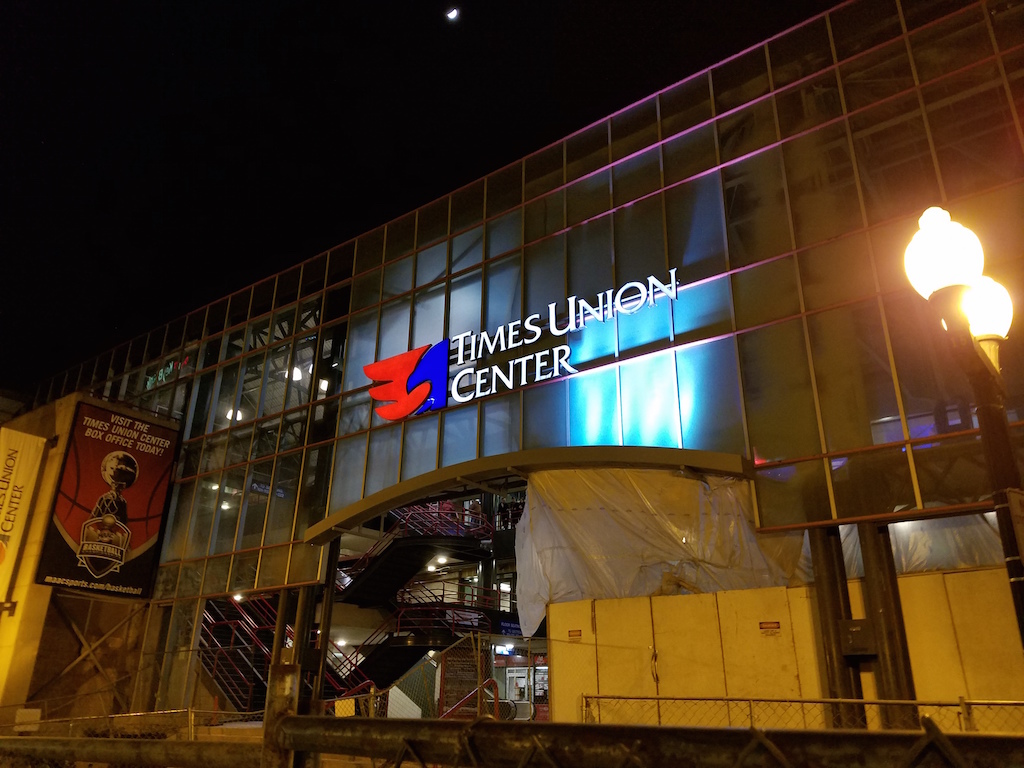
Pardon the mess. Photo by David Roth
To look at the careers of recent MAAC Players of the Year is to understand the conference’s place in the broader basketball firmament. Momo Jones transferred back east, transitioned from a rotation role at Arizona to a central one at Iona, and finished third in the nation in scoring as a senior; he is now playing for KK Mornar Basket Bar, in Montenegro. Keydren Clark led Division I in scoring twice at St. Peter’s, and is one of just eight players to score 3,000 points in his college career; he played for a decade all over Europe, led the Greek league in scoring twice, and eventually got dual citizenship in Bulgaria. Luis Flores, a two-time MAAC POY at Manhattan, got into 16 NBA games for two teams in ’04-05; Scott Machado, who won the award at Iona, played in six with the Rockets in ’12-13. Jason Thompson was a lottery pick out of Rider—by the Sacramento Kings, but it still counts—and played eight seasons in the NBA. Jared Jordan led Division I in assists two years running at Marist; in February, he became the all-time assist leader in the Basketball Bundesliga, Germany’s highest league. Kenny Hasbrouck is playing in Italy’s top league, and Ryan Rossiter is in Japan’s; their Siena teams were the last ones from the conference to win games in the NCAA Tournament, which they did in both 2008 and 2009. A year later, the University of Iowa hired away Siena’s coach, Fran McCaffery.
The defending MAAC player of the year, Monmouth’s Justin Robinson, won the honor for a second straight season on Friday night; when the announcement was made at halftime of Monmouth’s win over Niagara, the crowd barely rustled in response. Robinson is a 5-foot-8 point guard who played his high school ball in the small post-industrial city of Kingston, New York, which is about an hour’s drive from Albany and an hour-and-a-half’s drive north from New York City. Robinson grew up making trips to the Times Union Center to watch Tay Fisher, another undersized Kingstonian who was a star at Siena and now plays with the Harlem Globetrotters under the nom de hoop Firefly. Robinson attended Fisher’s summer camps in Kingston, then taught at them; he calls Fisher his cousin, although they’re not related. Monmouth was the only Division I school to offer Robinson a scholarship.
Robinson is an archetypal MAAC star—flawed and unremittingly chesty in performing his defiance of those flaws; locally grown and nationally un-recruited; nonconforming relative to the prevailing aesthetic standards of big-time college basketball and egregiously so by pro basketball ones; undeniably capable of Getting Buckets in any conceivable basketball context and exquisitely attuned to the various ways in which he has been and remains underestimated. There are the elements of other successful small players in his game—he scoots and slips like Tyler Ulis, has a repertoire of Isaiah Thomas-style floaters and high-spin off-angle finishes at the rim—but his role is different and simpler. He does the most difficult and most important work for his team, and has both the intuition and ferocity to understand and attack whatever that is from one moment to the next. In this conference and this context, it makes sense: his role is to be his team’s best player.
“He looked at me in the office when he first got there, and then we did a little meeting and he’s still looking at me, and his family is so excited and he’s just looking at me,” Monmouth coach King Rice remembered, after Robinson became the school’s all-time leading scorer earlier this season. “And I’m like, `Yo, little fellow, no one is scared of you.’ It was just the toughness that he walked around with on a daily basis being from Kingston.” Rice, who played for Dean Smith at North Carolina, grew up in Binghamton, which is a bigger, sadder version of Kingston a couple of hours west. These one- and no-industry cities and their respective basketball cultures are where the MAAC’s players come from, and what the MAAC feels like.
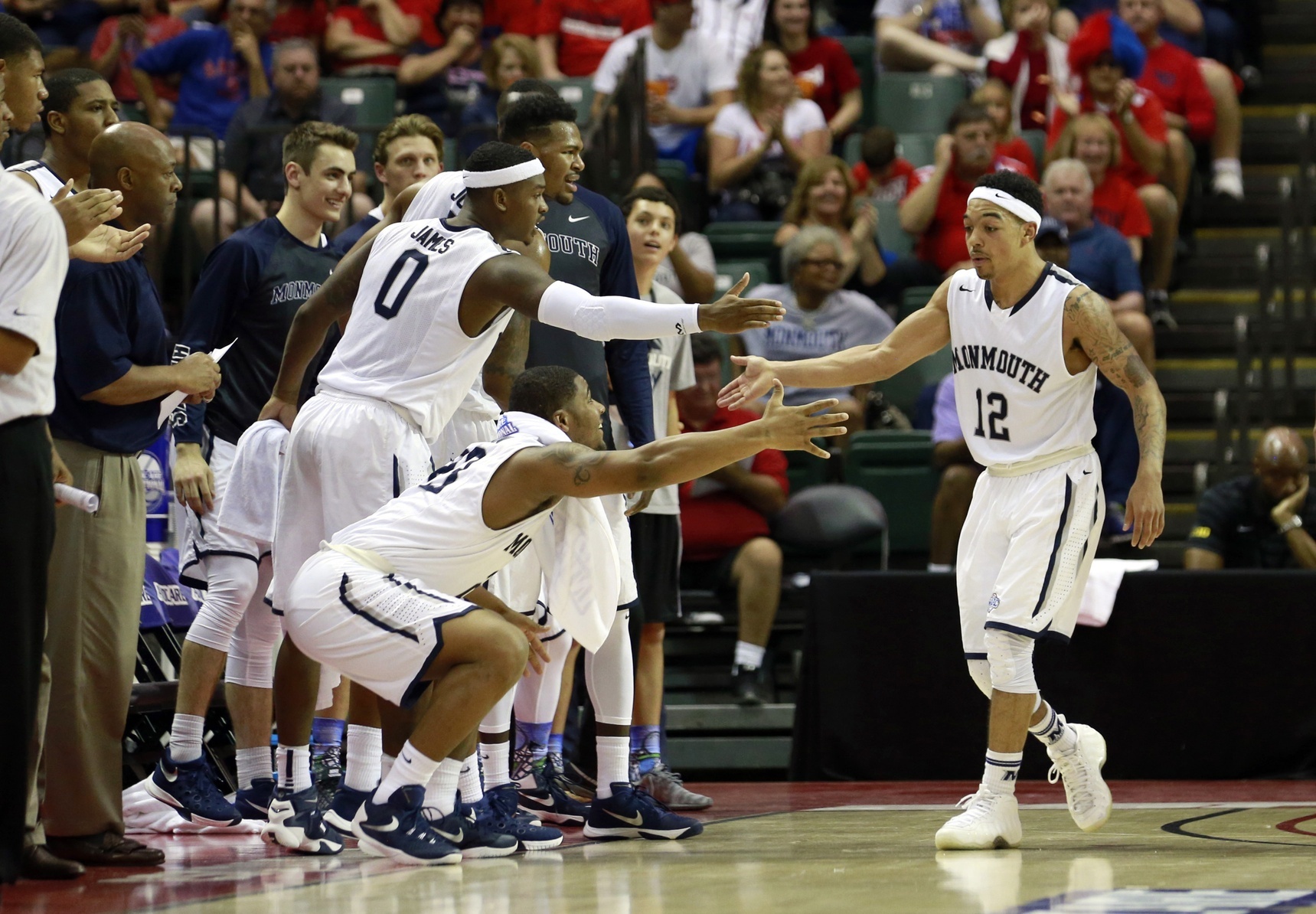
Good job, good effort. Photo by Kim Klement-USA TODAY Sports
Different types of soil are conducive to growing different types of grapes, which in turn become different types of wine; certain types of high schools in the American northeast—Catholic schools named after monsignors and monks and the better-known saints, public high schools in gray gnawed-down cities like Kingston—produce a certain type of stumpy-brash point guard, certain kinds of oblong or gangly bigs, certain kinds of white-haired men in sweaters who yell at them. If you consider basketball to have its own version of terroir, in which specific regions produce regionally specific types of players, Justin Robinson is very much A.O.C. MAAC. He is distinct and distinctive, but also distinctly and distinctively of a type.
If you grew up around it, or if you grew up watching college basketball as recently as the 1990’s, you might well have mistaken that type for College Basketball Itself. Some of this is simple coastal provincialism, and New York’s old tendency to mistake itself for the world. But some of it is the fact that, when college basketball and its ambient economy were smaller, the apex versions of these archetypes really were the sport’s foremost players. The various states that are carriers for college basketball’s particular heritable madnesses had their local heroes and made those teenagers into little gods in all the usual ways, but those big programs also imported sinewy point guards and bowling ball power forwards from those Jesuit basketball academies and concrete-town public schools. It was understood that those places—places like Albany, or Kingston, or Newark or Binghamton or Buffalo or Bethlehem, Pa.—were just where basketball players came from.
The top tier of national programs recruit not just nationally and globally but from commanding positions atop what is now a very sophisticated and efficient economy. It costs a great deal of money to be a part of this economy—there are a lot of people to pay, even if none of them are players, at least not above the table—but that intricate Basketball Talent Allocation System generally does an excellent job of making sure that the best players wind up in the best programs. Kevin Huerter, for instance, is the product of a local Albany basketball dynasty; his father played on the first Siena team ever to make a tournament, in 1989, and is a TV and radio commentator for the team now; Thomas Huerter Jr., Kevin’s older brother, is a reserve on the team. But Kevin Huerter starts in the backcourt for Maryland, not because Siena didn’t try to keep him but because it just wouldn’t have made sense for him to stay. A residual effect of all this sensible, rational sorting is that this sort of expertly sorted excellence is more and more the single distinguishing attribute that elite teams have; at the highest end, there is nothing that marks these programs as the product of any specific place or time, or anyway of any place and time beyond this one. They are all from everywhere, and have more in common with each other than the smaller schools that surround them.
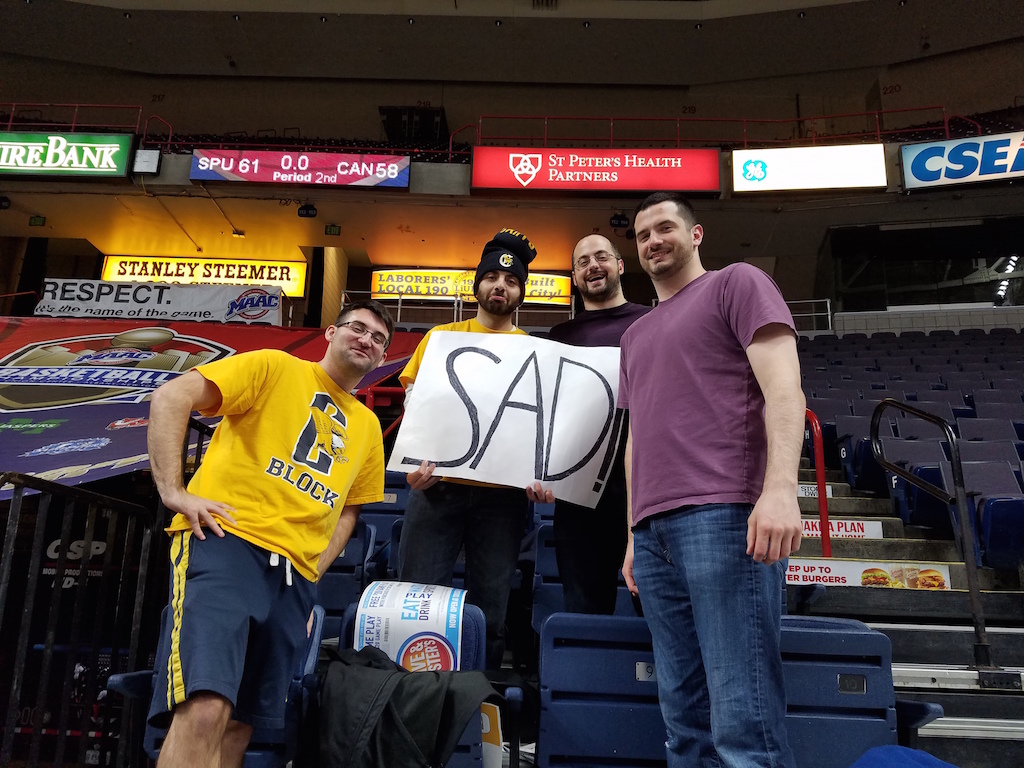
The funny thing is, they’re not even Canisius fans. Photo by David Roth
Every player comes from somewhere, of course, and every team is made of the same jagged human stuff. But the systems that produce those teams and the various imperatives and incentives and guiding economic forces of the college basketball business—all those sneaker companies and recruiting services and boosters and dicey rainmakers and subsidiary brands turning away in greasy synchronicity within the Talent Allocation System’s stainless housing—all work to push things in the direction of a progressively more efficient and less variable excellence. Everything becomes more like everything else. The aim is to create a basketball product as algorithmically reliable as a fast food burger. Raw materials enter the supply chain at one end and an endless series of 27-win seasons and Sweet 16 berths emerge at the other.
To a certain extent, that can be managed. To the extent that college basketball works, though—that is, aside from all the rotten congeries of contradictions and cynicisms that definite its business model—it is because of how unmanageable it is. Money can be spent to make sure that the right talent winds up in the right place, more money can be spent to fit locker rooms with marble or whatever other modish garishness, but there is no price that can take the chaos out of the games, or out of the chaotic unfinished hearts of the kids charged with bearing up under March basketball’s hot lights and pressure. The games are raw and raggedy, the players are always at least halfway out of their bodies, and that is always the case. That is the thrill of it, the fun of it, the thing about college basketball that redeems the indefensible rest—the ambient economy of college basketball perfects itself and perfects itself, aims itself towards an ever more perfect placelessness and an efficiency that approaches entropy, and then every year it just does not happen that way.
All that money and those multi-front efforts cannot control or even contain the chaos that is the essential condition of college basketball. Every year the programs that can afford to do so point their miraculous, expensive, glossy machine-crafted rosters towards the same goal. Every year some number of those powerful teams run into a teams from conferences like the MAAC, teams that that play in a local dialect that doesn’t translate, or in a way that is too new to be legible, or with a need that outraces containment, or that is otherwise just too strange for these machine-made teams to solve. Sand winds up in the gears. The machine stammers and sweats and smokes; the machine stops. The strange players, too short or too round or otherwise unfamiliar in name and shape, jump around and embrace at halfcourt. Sometimes they’re crying. They don’t know what to do with any of this, either.
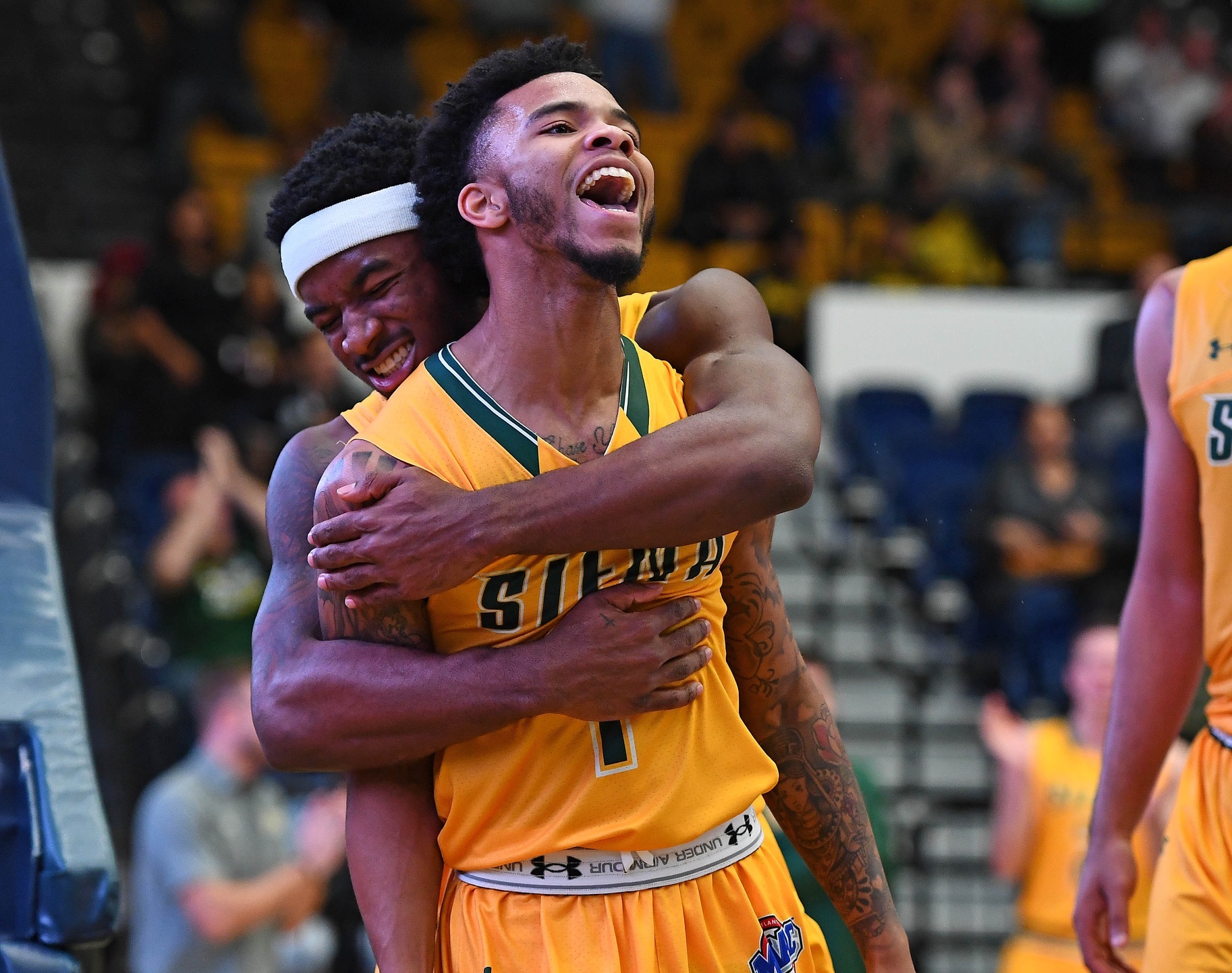
Hugs…by Nico. Photo by Brad Mills-USA TODAY Sports
Shortly after Monmouth lost to Siena in Sunday night’s first semifinal game, a young woman in a Monmouth sweatshirt flailed through the crowd of wide men in yellow sweatshirts and roiling giddy drunk students, cursing and fuming. “She’s pissed off,” a beer vendor said in what either sounded like or was an impressive imitation of the NBA Jam announcer. Monmouth guard Josh James had just left the floor in tears and disbelief; it was the second straight season that Monmouth ended a dominant season with a loss in the conference tournament. Last year’s Monmouth team had an excellent resume for an at-large bid, and this year’s isn’t bad, either, but conferences like the MAAC don’t get two bids to the tournament. All the teams are playing for one chance, and for as many chances after that as they can get.
Siena, whose quarterfinal win over Fairfield had ended roughly 16 hours before their semifinal tipped, had come back from a double-digit second half deficit thanks to the shooting of sixth man Nico Clareth, who was playing on an injured ankle that had caused him to miss the previous night’s game and left him running like a person trying to climb stairs in cross-country skis in this one. “He couldn’t walk two days ago,” Siena coach Jimmy Patsos said afterwards, in a postgame paean that mentioned both Willis Reed and Larry Bird. “He couldn’t walk in the first half.” In the second half, Clareth made seven three pointers; Monmouth’s Rice pointed out that five of them came with a defender’s hand in his face. Like many players on Siena’s roster, Clareth is from greater Baltimore, a region Patsos learned to recruit as an assistant to Gary Williams at Maryland and then head coach at Loyola.
Siena is the closest thing that the MAAC Tournament has to a home team. The university is in Albany, and its fan base—anecdotally, it is split between older men who refer to using the bathroom as “going to the little boys room” and the younger, drunker fans circulating word on Saturday that the Pearl Street Pub was definitely checking ID’s—has the shortest distance to travel. They are demanding and easily disappointed; Siena is an emotional, vexing team that makes a rather startling number of mistakes given how obviously well-coached they are. Patsos is a voluble, Rex Ryan-shaped man with nice suits and little gold buckles on his loafers; his team transparently loves him, and he transparently loves them back. He goes out of his way, after Saturday’s semifinal win, to make sure to wish Gary Williams a happy 72nd birthday.
Individually, his team, like all the others, is a collection of MAAC players—point guards who are too small, shooters who are too mercurial or unlucky, young people who make mistakes. Together, they are a MAAC team, which is something greater. MAAC players are heirloom specimens, the weird and specific products of weird and specific circumstances. Individually, they exist outside of the system that sustains the higher end of college basketball and pushes it further from the rest of it. Collectively, MAAC teams and the others in college basketball like them are something different—something more restless, a problem more difficult to solve, a team that comes from a place that elite programs might struggle to understand. Collectively, in their defiant and angular totality, in their specificity and strangeness, these teams tend to be hard to beat.
Want to read more stories like this from VICE Sports? Subscribe to our daily newsletter.




